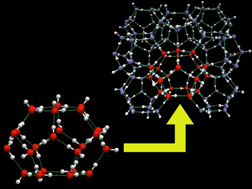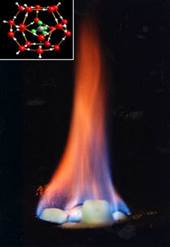Architecture of Ice Cages May Revolutionize Hydrogen Storage
Scientists have known for the past 25 years that the largest reserves of natural gas on the planet lie on the ocean floor. The natural gas is held in tiny ice cages called hydrates.
A hydrate forms under a narrow range of temperature and pressure conditions that cause water molecules to link together and form cages. The structure is stabilized by ‘guest' gas molecules that reside inside the cage. Ideal ‘guest' gases include hydrogen, methane, and carbon dioxide.
This concept has led many scientists to wonder if hydrates hold the potential of a practical hydrogen storage material for mobile applications. Hydrates are a clean, safe and inexpensive medium to store hydrogen gas, but their storage capacity and stability make them unsuitable for on-board hydrogen storage.
Undaunted, scientists are using their knowledge of how hydrates form in nature to investigate whether they can be used as an on-board hydrogen storage system as the next stage in energy evolution.
The actual structure of the hydrate is constructed using unit cell building blocks of cages of various sizes. Scientists have determined there are three different unit cells that can be assembled into countless combinations to form millions of different hydrate lattice arrangements.
Hydrate structure is critical because it is the ultimate control for determining the amount of gas that the hydrate can hold. Until recently scientists have been unable to determine the most stable lattice structures.
Previous work using X-rays revealed the location of oxygen atoms of the water molecule in the hydrate structure, but not the location of the hydrogen atoms. For a given arrangement of the oxygen atoms, there are many millions of arrangements of the hydrogen atoms. Without a clear understanding of where the hydrogen atoms are located, it is impossible to identify the most stable lattice structures.
Scientists at Pacific Northwest National Laboratory (PNNL) and the Russian Academy of Sciences approached this problem from a different perspective. They developed a discrete model that determines the stability of different configurations of the water cage building blocks in the different lattice structures.
Dr. Sotiris S. Xantheas and colleagues began with the smallest water cages that consist of 20 and 24 water molecules. These small cages still boasted over 3,000,000 different network arrangements.
Scientists ran their computer model on the "Chinook" supercomputer at PNNL's Environmental Molecular Sciences Laboratory. Capable of 163 teraflops, Chinook enabled the scientists to quickly screen the different unit cell configurations to identify the most stable arrangements.

Image credit: Soohaeng Yoo and Sotiris Xantheas, Pacific Northwest National Laboratory
Architecture of water cage structure
Following this approach, the scientists narrowed their study to a more manageable number of just a few hundred arrangements. This group is currently being refined using the Oak Ridge National Laboratory's supercomputer "Jaguar", which is capable of 1.64 petaflops.
The combined effort of these two powerful computers allowed scientists to quickly screen and identify the most stable arrangements.
"Preliminary evidence suggests that the stable lattice structure produced using the simplest unit cells can hold more hydrogen gas than previously believed" said Xantheas.
Xantheas likens this basic research to the invention of television. "Someone didn't just wake up one morning and invent the television. This technology was a combined effort over a period of years to develop the electronics that ultimately led to the development of the television."
A model will only take this field so far. The next step is to take these results to the lab to determine how the different hydrate structures hold up under experimentation.
"Experimental work for developing a hydrogen storage system is faced with the Goldilocks problem — we have materials that hold on to the hydrogen too tightly and other materials that do not hold on to the hydrogen strongly enough. We are looking for a structure that is just right" said Wendy Mao, a researcher at Stanford University.
Mao takes the theoretical results produced by Xantheas's computer models to accelerate the experimental approach.
"There are so many hydrate lattice structures that we need guidance on what to study. The theoretical approach screens the structures, which narrows the structures we use in our experiments. This process makes the pursuit for a hydrogen storage system more efficient," said Mao.
In the future, Xantheas plans to incorporate the other two hydrate unit cells into the computer model to simulate more complex lattice structures. Mao is tackling how to improve hydrogen binding in these structures to find the structure that is ‘just right' for hydrogen storage.
"I believe this work will stimulate the interest of the scientific community and it will ultimately advance this important area of energy science" said Xantheas.
This basic science study is supported by the Department of Energy's (DOE) Office of Science, Office of Basic Energy Sciences. DOE invests in science and solving critical issues impacting people's daily lives and the nation's future.
EMSL is a national scientific user facility sponsored by DOE's Office of Science, Biological and Environmental Research program that is located at Pacific Northwest National Laboratory.
This article was written by Stacy W. Kish.

 Image credit: United States Geological Survey.
Image credit: United States Geological Survey.